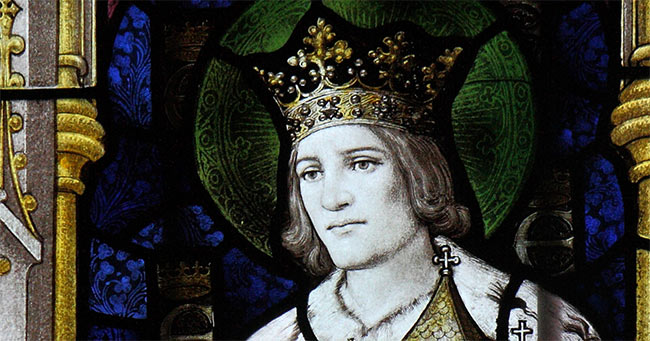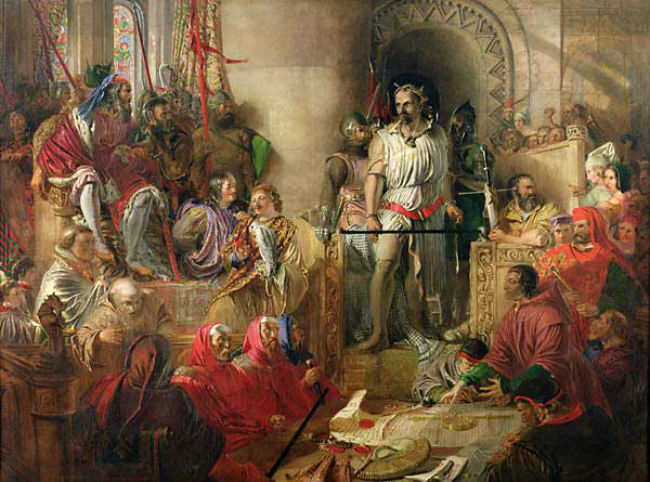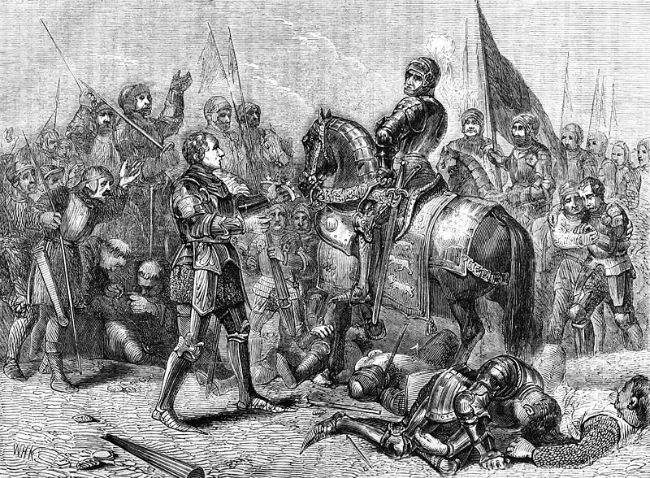
The Medieval period stretched from the 5th Century, when Britain emerged from the collapse of the Roman Empire, to the 15th Century. In the wake of the Romans, the country was riven by tribal divisions and competition for power regularly resulted in bloody conflict. Over the coming centuries, throughout the Anglo-Saxon and Norman eras, peace was rarely maintained for long.
Battle of Hatfield Chase, 633

King Edwin, the defeated Northumbrian king, pictured in stained glass at St Mary, Sledmere, Yorkshire.
Pitting the Northumbrians, commanded by Edwin, against a Gwynedd-Mercian alliance led by Cadwallon ap Cadfan, the King of Gwynedd, and Penda, the Pagan King of Mercia.
Edwin, the Christian King of Northumbria and the most powerful ruler in Britain, was killed and his army defeated. His kingdom fell into disarray and was divided between its sub-kingdoms of Deira and Bernicia.
Battle of Stamford Bridge, 1066
The morning of 25 September 1066 saw King Harald Hardrada’s invading Viking force defeated in a bloody battle at the village of Stamford Bridge in the East Riding of Yorkshire.
Having learned of a Norwegian invasion in the North, King Harold Godwinson marched his army 185 miles from London in just four days, before taking Harald’s men by surprise and gaining a decisive strategic advantage.
 Watch Now
Watch NowBattle of Hastings, 1066
Following victory at the Battle of Stamford Bridge, Harold Godwinson’s only serious competitor for Edward the Confessor’s recently vacated throne was Willian of Normandy.
William’s forces landed on the south coast and Harold’s men marched south to meet the invasion. Harold’s attempt to surprise William were confounded by scouts and the Normans advanced towards his army.
Fighting began at 9.00 AM on Saturday 14 October 1066, 7 miles north of Hastings. Harold was famously struck by an arrow to the eye and killed, leaving the English forces leaderless, and the Normans prevailed.
Battle of the Standard, 1138
Also known as the Battle of Northallerton, the Battle of the Standard was the first significant engagement between Scotland and England since the Norman conquest.
The battle saw Scottish forces, led by King David I, descend on England, where they were met by an English army of around 10,000 recently recruited men who, despite being outnumbered, managed to repel the Scots.
It was a “shattering defeat” that is said to have resulted in around 12,000 Scottish casualties. Nonetheless, the English failed to pursue the retreating Scots and David was able to consolidate his gains in the North of England.
Battle of Lewes, 1264
The Battle of Lewes was a landmark battle in the Second Barons’ War, in which Henry III’s autocratic rule was challenged by a group of disenchanted barons led by Simon de Montford.
Despite the Royal army’s significant numerical advantage, De Montford’s baronial troops made the most of a strong position atop Offham Hill and routed Henry’s men.
De Montford ruled as the ‘uncrowned king of England’ for about a year before Edward exacted revenge at the Battle of Evesham.
Battle of Falkirk, 1298
After a famous victory over the English at Stirling Bridge the previous year, William Wallace’s Scottish army faced a response from Edward I, who led a significant army into in pursuit of Wallace and his men.
Knowing his army was no match for the English this time, Wallace employed hit and run tactics, aiming to impair Edward’s progress into Scotland while avoiding a full-scale battle.
Ultimately, he was forced to engage the English at Falkirk and his ill-matched troops were summarily defeated. It was a devastating loss for Wallace in the First War of Scottish Independence and he resigned his guardianship later that year.

The trial of William Wallace at Westminster after his defeat and arrest at the Battle of Falkirk.
Battle of Bannockburn, 1314
Robert the Bruce had seized the Scottish throne in 1306, reigniting the War of Scottish Independence. In opposition, the English were now ruled by Edward II, whose leadership was proving less incisive than his father’s.
By 1314, Robert had reclaimed many of the Scottish castles that had been held by Edward I and was on the cusp of capturing Stirling Castle, England’s last great stronghold in Scotland.
The prospect of Stirling’s surrender to the Scottish provoked Edward II to march north from Berwick with a 15,000 – 20,000 strong army. Robert the Bruce met the force with a considerably smaller army, but his preparations were ingenious.
His men outmanoeuvred Edward’s troops by penning them between the banks of the Bannock stream and the pikes of dense formations of spearmen (known as schiltroms).
Against the odds, the English were routed and Robert the Bruce won a famous victory.
Battle of Shrewsbury, 1403
The powerful Percy family had supported King Henry IV when he took Richard II’s throne in 1399.
Various disputes had frustrated them to the extent that they withdrew their support for the new king and formed an alliance with Glyndŵr and Edward Mortimer to conquer and divide up England.
Sir Henry ‘Hotspur’ Percy, a knight famed for his fiery temperament and prowess on the battlefield, gathered an army and joined forces with the other rebels at Shrewsbury.
A fierce longbow battle ensued and Hotspur was struck in the face and killed when opening his visor. With the rebels’ celebrated leader dead, the battle dissipated and Henry IV claimed victory.
Battle of Tewkesbury, 1471
Following their defeat at the Battle of Barnet, the Lancastrian army, led by the Duke of Somerset and Queen Margaret, were on their way to Wales. Once there, Somerset hoped to reinforce his troops.
Learning of the Lancastrians’ movements, King Edward IV decided to intercept them. He pursued them to Tewkesbury where Somerset opted to take up a defensive position rather than get caught attempting to cross the River Severn.
After initially showering the Lancastrians with arrows, the Yorkist beat them back to the banks of the river where 2,000 Lancastrians were killed as the Yorkist prevailed.
The victory was decisive enough that Edward’s rule remained uninterrupted by conflict for the next 12 years.
 Watch Now
Watch NowBattle of Bosworth Field, 1485
The last significant battle of the War of the Roses, Bosworth Field saw Richard III lead a substantial army of around 15,000 men (complete with a formidable arsenal said to include 140 cannons) into battle against rebel forces led by Henry Tudor, the would-be Lancastrian King.
The Lancastrians were reinforced by Lord Thomas Stanley’s private army of 6,000 men. With the battle raging, Richard decided to make a decisive move and led a small cavalry detachment straight for Henry.
At this point Lord Stanley’s men joined the fray in defence of Henry. Richard’s horse was bogged down in the mud, leaving him to fight on foot. Inevitably he was struck down and the Yorkists were defeated.

Lord Thomas Stanley presenting his step-son, Henry Tudor, with Richard’s fallen crown after the Battle of Bosworth.
Richard III was the last monarch to be killed in battle and, with his death, the last Plantagenet king.
















